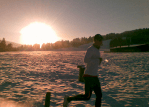 By Brandon Cooper > Junior > Journalism > University of Maryland, Photo by Cyril Vallee
By Brandon Cooper > Junior > Journalism > University of Maryland, Photo by Cyril Vallee
If anyone has ever watched a football game being played outside in December or January, they probably noticed some of the player’s lack of clothing.
With temperatures well below freezing and snow falling fast, big-time players like Pittsburgh’s Troy Polamalu and Green Bay’s Clay Matthews stick to short sleeves to perform at their best.
But, most of us are not Polamalu or Matthews. And when the average person runs, trains and exercises, they need to be better prepared to deal with the inclement weather.
There are some specific considerations athletes and runners should keep in mind while exercising outside during the winter.
Don’t Sweat It
A runner training in the winter should wear multiple layers to keep warm during their exercise. However, a runner should monitor when they become too hot and begin sweating.
According to Jay Johnson of Nike Running, a wet and sweaty body will become cold much quicker, especially if the runner begins to slow down and walk. This can lead to the runner catching hypothermia.
Cotton is the Enemy
While a runner should wear multiple layers to stay warm, none of these materials should be cotton.
According to Dr. Stephen Pribut, a podiatrist from Washington D.C. who writes on Sports Medicine, cotton soaks up moisture and sweat and will keep that wetness on the body.
This intensifies the problem of sweating by keeping it close to your skin. Instead, a runner should have layers of thinner and more breathable materials, like Gore-Tex or polypropylene.
Get H2O before Running through It
According to Jay Johnson of Nike Running, the colder the temperature gets, the harder it is for the body to tell it is thirsty. Meanwhile, the runner still loses water as they move along on their exercise, leading to dehydration. It is important for runners to drink enough water to stay hydrated, even if they don’t feel as thirsty as they might if it were hot out.
Feel the Wind at Your Back
Once a runner starts getting going in their workout, one of the best ways to ensure the cold does not creep in to their body is to run with the wind at their back.
The Mayo Clinic recommends people run with the wind at their back during the second half of their run because it decreases the chances of a runner feeling the chill of a wind.
This is especially true is the runner has worked up a sweat, as the wind can intensify the cold feeling a runner gets when wet.
Stay Safe
No matter where a runner exercises or how they prepare for a run in the winter, there will always be a risk when training.
It is important for any athlete to understand their limitations when training in the cold and modify their run to fit these constraints.



















